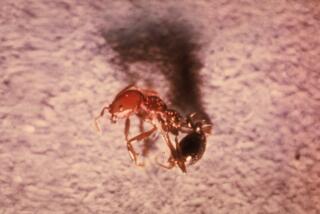Weaving a tangled web: How spiders engineer traps
Think that cobweb in the corner looks like a haphazard collection of silk threads? Take a closer look -- preferably with a scanning electron microscope.
It’s long been known that spiders use a variety of tailor-made silks to cover their eggs, construct nets and maneuver around on.
Now, a team of biologists and polymer scientists say spiders also use specialized techniques to secure cobweb strands depending on the prey they hope to catch.
In a paper published Tuesday in the journal Nature Communications, scientists described two very different anchors, or discs, that cobweb spinning spiders like the western black widow use to ensnare dinner. (Cobweb-spinning spiders erect three-dimensional webs, whereas orb-spinning spiders build flat, two-dimensional webs.)
Web strands that are intended to capture a speeding fly, and withstand its desperate struggle to escape, must be extremely strong. Crawling prey, however, present a very different problem. The silk strands that entangle them and lift them up off the ground like a snare trap must be engineered to break free very easily.
After examining numerous cobwebs under an electron microscope and performing tests with tape and nylon thread, polymer scientist Vasav Sahni of the University of Akron and colleagues described the two types of discs.
Extremely strong “staple pin” discs anchored lines for flying insects. Spiders created the staple pin anchors by applying numerous shorter lines in a perpendicular fashion over the the main web line, like laces covering the seam of a football. This form of anchor was so strong, authors said, that the main web line would break before the anchor lines did.
Lines intended to capture crawling prey, however, were anchored with so-called gumfoot discs. In this technique, the anchoring lines stretch radially from the main web strand, like spokes on a wheel. These short anchoring fibers hold the main line taught, but their attachment to the ground is weak, and easily broken by a lumbering insect. Once this happens, the main line lifts the prey off the ground and suspends it in the air where the spider can subdue it.
Study authors said their research proved that it was the architecture of the web anchors and not the chemical makeup of the spider silk that determined the strength of anchoring discs.







